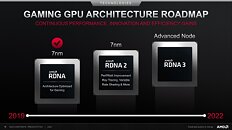
AMD ROCm 5.5 Now Available on GitHub
As expected with AMD's activity on GitHub, ROCm 5.5 has now been officially released. It brings several big changes, including better RDNA 3 support. While officially focused on AMD's professional/workstation graphics cards, the ROCm 5.5 should also bring better support for Radeon RX 7000 series graphics cards on Linux.
Surprisingly, the release notes do not officially mention RDNA 3 improvements in its release notes, but those have been already tested and confirmed. The GPU support list is pretty short including AMD GFX9, RDNA, and CDNA GPUs, ranging from Radeon VII, Pro VII, W6800, V620, and Instinct lineup. The release notes do mention new HIP enhancements, enhanced stack size limit, raising it from 16k to 128k, new APIs, OpenMP enhancements, and more. You can check out the full release notes, downloads, and more details over at GitHub.
Surprisingly, the release notes do not officially mention RDNA 3 improvements in its release notes, but those have been already tested and confirmed. The GPU support list is pretty short including AMD GFX9, RDNA, and CDNA GPUs, ranging from Radeon VII, Pro VII, W6800, V620, and Instinct lineup. The release notes do mention new HIP enhancements, enhanced stack size limit, raising it from 16k to 128k, new APIs, OpenMP enhancements, and more. You can check out the full release notes, downloads, and more details over at GitHub.






























































